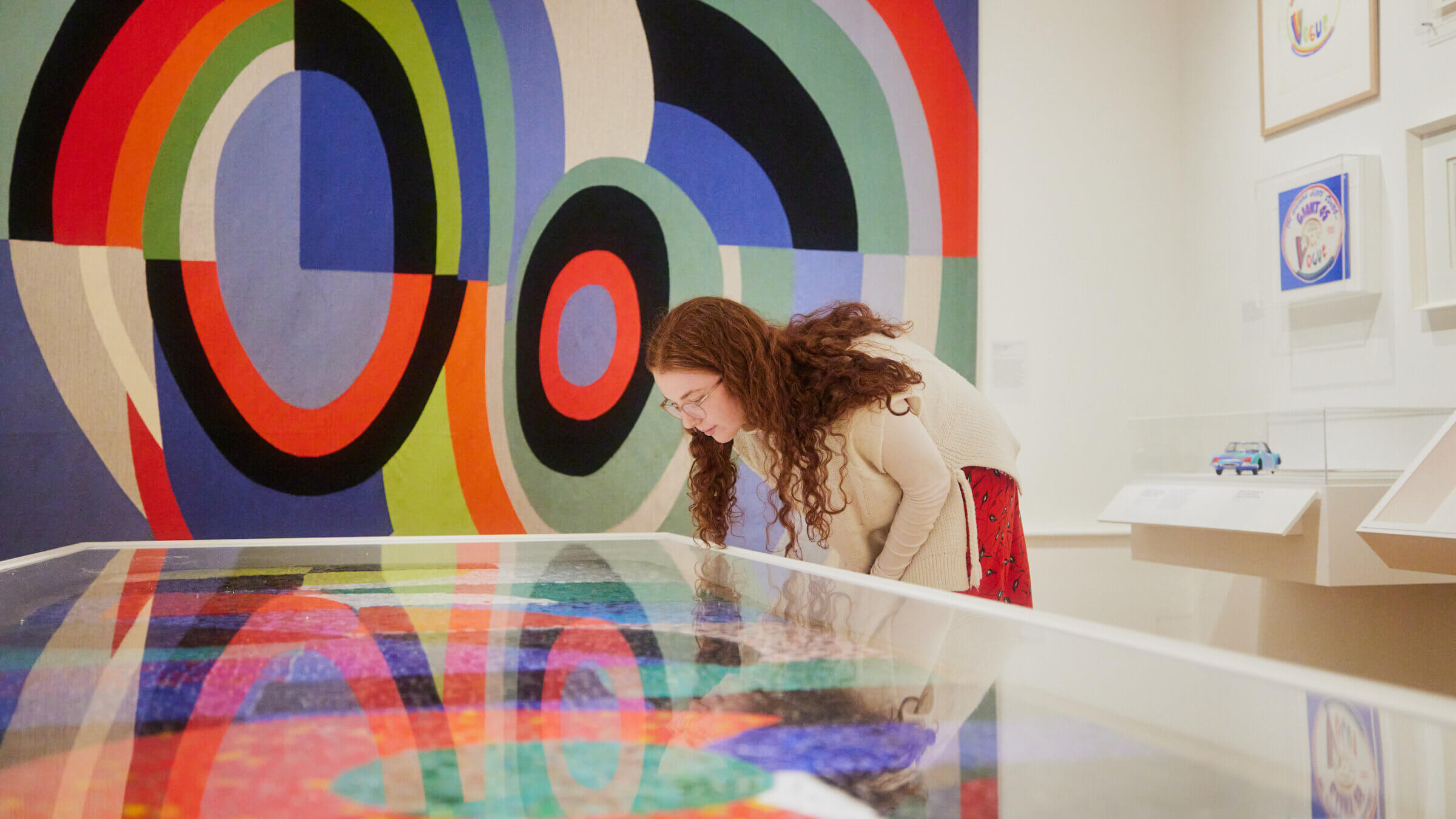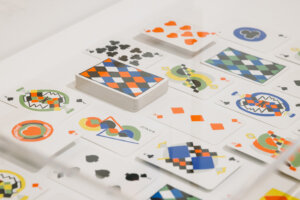This Jewish artist got her start before WWI. A century later, she’s still in the avant garde
In the early 20th century, Odessa-born artist Sonia Delaunay pioneered abstract paintings, whimsical furniture and boldly patterned textiles that feel wholly contemporary today.

A wide-ranging exhibit at Manhattan’s Bard Graduate Center displays paintings, textiles, films and objects created by the Jewish artist Sonia Delaunay. Photo by Brayden Heath, Bard Graduate Center
If you think you’re unfamiliar with the Odessa-born, French Jewish avant-garde artist Sonia Delaunay, you might change your mind as you view the swirling colors, intricate geometric patterns, and playful designs that fill four floors of exhibit space at Manhattan’s Bard Graduate Center’s exhibit in Manhattan. The more than 200 items on display in “Sonia Delaunay: Living Art” range from collage-like abstract paintings to elegant clothing, from fashionable stage designs to eclectic posters, book covers, mosaics and home furnishings. The newest among these objects are at least fifty years old. Yet it’s impossible not to recognize the artist’s continuing influence and contemporary relevance in the multi-hued pop- and op-art accents that brighten so much of the clothing we wear, the ads we see, and the interiors we live in today.
That makes “Living Art” a more than apt title for the exhibit. Creating art that “becomes part of modern life and that can play a role in the everyday was one of the core objectives” of early 20th-century artists like Delaunay, said co-curators Laura Microulis and art historian Waleria Dorogova via email. They said the exhibit’s title derives from Delaunay’ sensibility, “her own lived experience, and her desire to create works that add beauty and spirit to daily life.”

Born in 1885, Delaunay spent her first five years with her working-class Jewish family in Odessa before her parents sent her to live with wealthy relatives, Genrikh and Anna Terk, in St. Petersburg. Cultured and assimilated to the extent possible within Russia’s virulently anti-Semitic society, they changed their young ward’s birth name, Sara Elievna Stern, to the less Jewish-sounding Sophia Terk, and nicknamed her Sonia.
From her parents, Delaunay had learned Yiddish, which she continued to speak throughout her life with friends like the Russian-Jewish artist Marc Chagall. But the aristocratic Terks hired tutors to teach her French, English and German, and to instruct her in both art and music. Despite her privileged life, she could not escape exposure to the graphic reports of the violent Kishinev pogrom of 1903, and wrote emotional entries in her diary about feeling connected to the Jewish people. Still, for the rest of her life, she mostly downplayed or hid her Jewish origins—sometimes out of necessity, as when she lived in France during World War II.

Delaunay moved to Paris in 1906. There, she discovered the avant-garde techniques and movements of the era, including the strong colors favored by Fauvist artists such as Henri Matisse, and the geometrically fractured abstractions of Cubists like Pablo Picasso. In 1910, she married fellow artist Robert Delaunay; their son, Charles, was born in 1911.
Losing no time in unifying her life with her art, Delaunay quilted a Cubist-style patchwork crib cover for the infant. Similarly, one of the most charming objects in the exhibit is the wooden toy box she created for Charles, which she painted in a joyful riot of multi-colored squares, circles, and other geometric shapes.
The exhibit makes clear that as a young mother and throughout her career, Delaunay viewed art as the stuff of life, and life as the essence of art. “Everything is a movement of color within depth,” she wrote in a notebook in 1913. “Everything is simultaneous and all celestial.”
A savvy businesswoman, the artist also used this vision of the “simultaneity” of color and the unity of art and life to create a brand for her work. In 1913, she designed her first “simultaneous” fashions, most notably the Robe simultanée, exhibited here for the first time in the United States. In this and other of her so-called simultaneous designs, Delaunay would stitch together brightly colored swatches of fabric of different shapes and sizes, in effect creating an elegant, costume-like patchwork quilt. She used photographs of herself wearing her inaugural simultaneous garment at artistic soirées to publicize and promote her fashion designs. For her husband, she devised a similarly styled “simultaneous vest,” that would not look out of place in a swank nightclub.
Also on display are Delaunay’s sketches and photos of her gilded, glittery costume and stage designs for the 1917 Ballet Russes production of Cleopatra. Those have not aged well, unlike other designs which I’d put on my personal wish list if they were available today. My favorites include the ultra-chic cream-and-pastel felted wool cloche and scarf set from the 1920s; a sky-blue tunic of knitted and embroidered silk and decorative trim; and silk crepe-de-Chine fabrics printed with colorfully stylized leaves and blossoms.
In the 1920s, Delaunay’s designs were available from Maison Sonia, the commercial name she used for the workshop and fashion salon she operated out of her apartment. Her name was well-known thanks to her marketing savvy, as shown here in the eye-catching posters and advertisements, all characterized by her signature whirling circles of color and light. Of particular interest is the 1926 film made by both Delaunays, which features a model clad in a geometric-patterned Delaunay dress standing before a color wheel and slowly turning it to demonstrate the fluidity — and unity — of color.

Delaunay also began adding furniture and interior design to her artistic portfolio. Among the furniture pieces she designed for her apartment — which did triple-duty as home, workshop and showroom — is the maple-and-sycamore sideboard, with geometric veneer. We see a more whimsical side of Delaunay in her décor for the room of a friend’s six-year old daughter, which featured white curtains patterned with large circular dollops of color and a white table painted to match.
Just before Germany invaded France in 1940, Delaunay and her husband fled Paris for the south of France, where Robert died in 1941. Throughout the rest of the war, she moved frequently to avoid arrest. In 1946, she returned to Paris, where she continued to live and work until her death in 1979.
Today, she is considered a pioneer of abstract art. This viewer also sees her as an early “influencer” of art and fashion trends who flourished long before that word was coined. “One of Sonia Delaunay’s greatest skills was her ability to translate her artistic ideas across an astounding variety of artistic mediums, an ability that manifested itself early in her life and grew stronger as her output became increasingly diversified,” the exhibit curators wrote via email. “She masterfully applied her characteristic treatment of form and color to her fashion and textile designs, creating artisanal garments and accessories with a bold, painterly sensibility.”
Even so, in recent decades her work has not received as much exposure in the United States as in Europe. This impressive exhibit presents her and all her diverse achievements to the American audience she so fully deserves.





















